Page 165 of 474
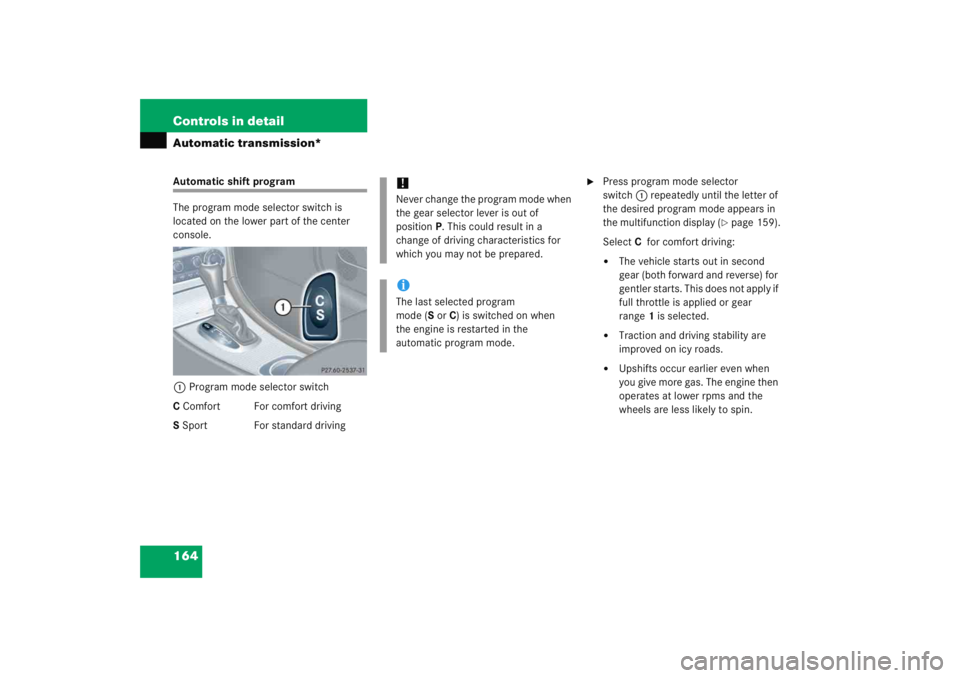
164 Controls in detailAutomatic transmission*Automatic shift program
The program mode selector switch is
located on the lower part of the center
console.1 Program mode selector switch
C Comfort For comfort driving
S Sport For standard driving
�
Press program mode selector
switch 1 repeatedly until the letter of
the desired program mode appears in
the multifunction display (
�page 159).
Select Cfor comfort driving:
�
The vehicle starts out in second
gear (both forward and reverse) for
gentler starts. This does not apply if
full throttle is applied or gear
range 1 is selected.
�
Traction and driving stability are
improved on icy roads.
�
Upshifts occur earlier even when
you give more gas. The engine then
operates at lower rpms and the
wheels are less likely to spin.
!Never change the program mode when
the gear selector lever is out of
position P. This could result in a
change of driving characteristics for
which you may not be prepared.iThe last selected program
mode ( Sor C) is switched on when
the engine is restarted in the
automatic program mode.
Page 166 of 474
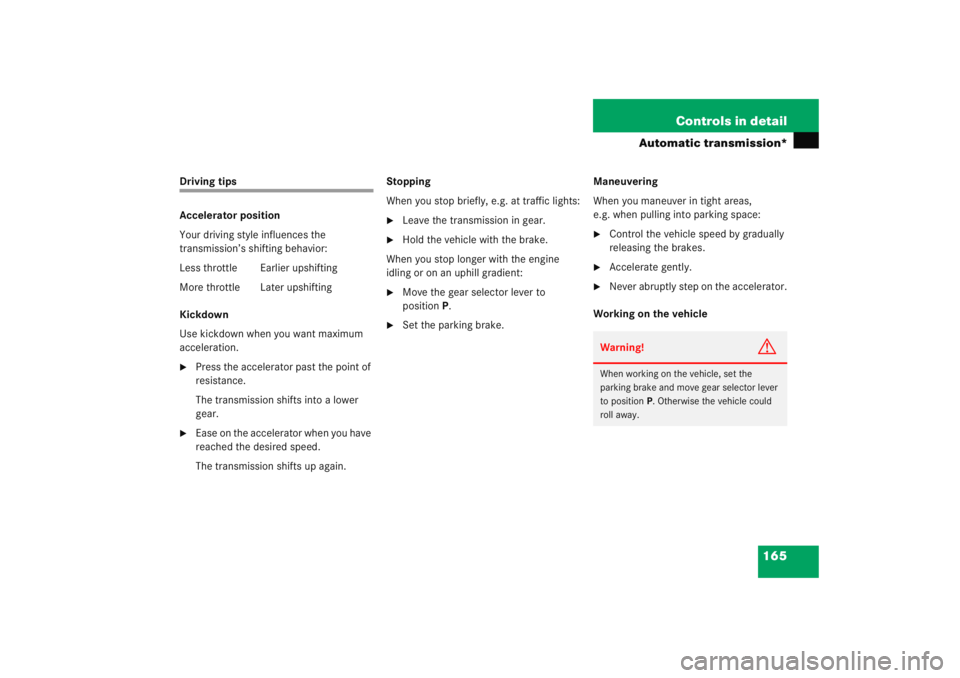
165
Controls in detail
Automatic transmission*
Driving tips
Accelerator position
Your driving style influences the
transmission’s shifting behavior:
Less throttle Earlier upshifting
More throttle Later upshifting
Kickdown
Use kickdown when you want maximum
acceleration.�
Press the accelerator past the point of
resistance.
The transmission shifts into a lower
gear.
�
Ease on the accelerator when you have
reached the desired speed.
The transmission shifts up again.
Stopping
When you stop briefly, e.g. at traffic lights:
�
Leave the transmission in gear.
�
Hold the vehicle with the brake.
When you stop longer with the engine
idling or on an uphill gradient:
�
Move the gear selector lever to
position P.
�
Set the parking brake. Maneuvering
When you maneuver in tight areas,
e.g. when pulling into parking space:
�
Control the vehicle speed by gradually
releasing the brakes.
�
Accelerate gently.
�
Never abruptly step on the accelerator.
Working on the vehicleWarning!
G
When working on the vehicle, set the
parking brake and move gear selector lever
to position P. Otherwise the vehicle could
roll away.
Page 167 of 474
166 Controls in detailAutomatic transmission*Emergency operation (Limp Home Mode)
If vehicle acceleration worsens or the
transmission no longer shifts, the trans-
mission is most likely operating in limp
home (emergency operation) mode. In this
mode only second gear and reverse gear
can be activated.
�
Stop the vehicle.
�
Move gear selector lever toP.
�
Turn off the engine.
�
Wait at least ten seconds before
restarting.
�
Restart the engine.
�
Move gear selector lever to position D
(for second gear) or R.
�
Have the transmission checked at an
authorized Mercedes-Benz Center as
soon as possible.
Page 249 of 474
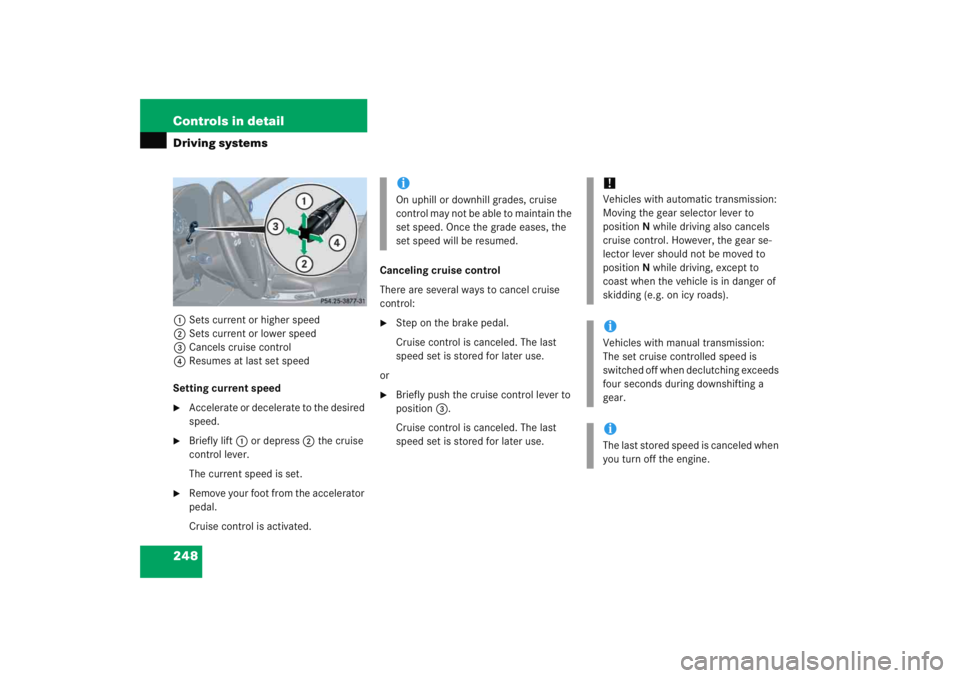
248 Controls in detailDriving systems1Sets current or higher speed
2 Sets current or lower speed
3 Cancels cruise control
4 Resumes at last set speed
Setting current speed�
Accelerate or decelerate to the desired
speed.
�
Briefly lift 1 or depress 2 the cruise
control lever.
The current speed is set.
�
Remove your foot from the accelerator
pedal.
Cruise control is activated. Canceling cruise control
There are several ways to cancel cruise
control:
�
Step on the brake pedal.
Cruise control is canceled. The last
speed set is stored for later use.
or
�
Briefly push the cruise control lever to
position 3.
Cruise control is canceled. The last
speed set is stored for later use.iOn uphill or downhill grades, cruise
control may not be able to maintain the
set speed. Once the grade eases, the
set speed will be resumed.
!Vehicles with automatic transmission:
Moving the gear selector lever to
position N while driving also cancels
cruise control. However, the gear se-
lector lever should not be moved to
position N while driving, except to
coast when the vehicle is in danger of
skidding (e.g. on icy roads).iVehicles with manual transmission:
The set cruise controlled speed is
switched off when declutching exceeds
four seconds during downshifting a
gear.iThe last stored speed is canceled when
you turn off the engine.
Page 250 of 474
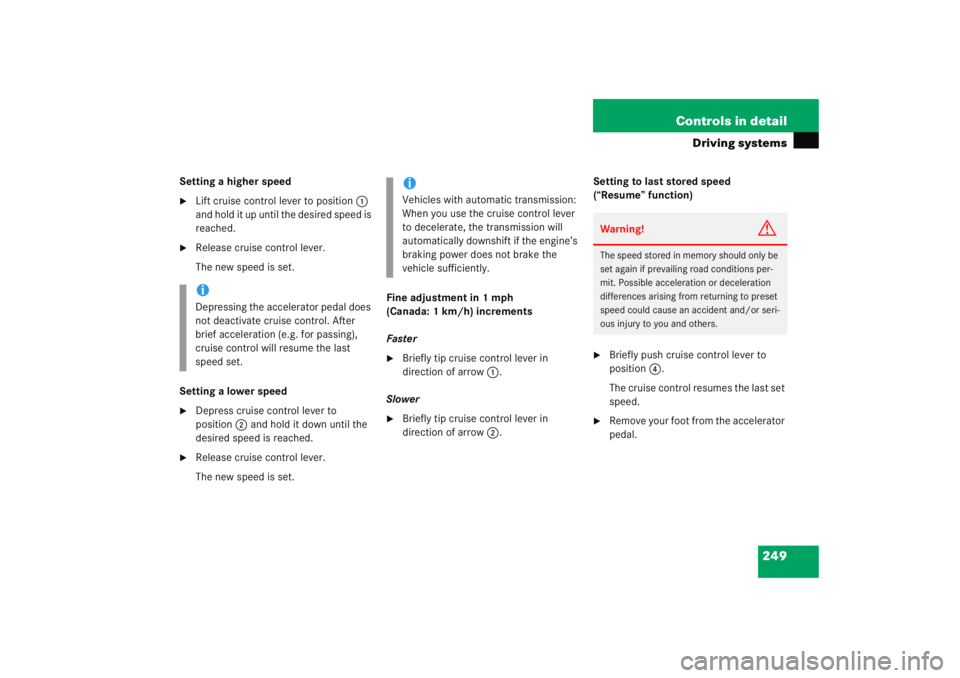
249
Controls in detail
Driving systems
Setting a higher speed�
Lift cruise control lever to position
1
and hold it up until the desired speed is
reached.
�
Release cruise control lever.
The new speed is set.
Setting a lower speed
�
Depress cruise control lever to
position 2 and hold it down until the
desired speed is reached.
�
Release cruise control lever.
The new speed is set. Fine adjustment in 1 mph
(Canada: 1 km/h) increments
Faster
�
Briefly tip cruise control lever in
direction of arrow
1.
Slower
�
Briefly tip cruise control lever in
direction of arrow 2. Setting to last stored speed
(“Resume” function)
�
Briefly push cruise control lever to
position
4.
The cruise control resumes the last set
speed.
�
Remove your foot from the accelerator
pedal.
iDepressing the accelerator pedal does
not deactivate cruise control. After
brief acceleration (e.g. for passing),
cruise control will resume the last
speed set.
iVehicles with automatic transmission:
When you use the cruise control lever
to decelerate, the transmission will
automatically downshift if the engine’s
braking power does not brake the
vehicle sufficiently.
Warning!
G
The speed stored in memory should only be
set again if prevailing road conditions per-
mit. Possible acceleration or deceleration
differences arising from returning to preset
speed could cause an accident and/or seri-
ous injury to you and others.
Page 324 of 474
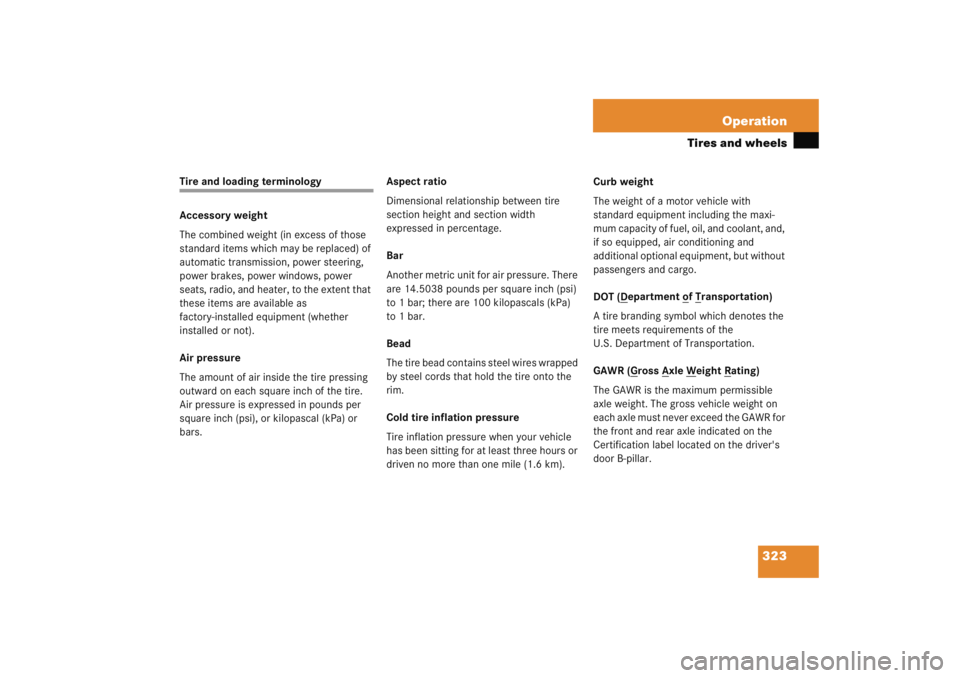
323
Operation
Tires and wheels
Tire and loading terminology
Accessory weight
The combined weight (in excess of those
standard items which may be replaced) of
automatic transmission, power steering,
power brakes, power windows, power
seats, radio, and heater, to the extent that
these items are available as
factory-installed equipment (whether
installed or not).
Air pressure
The amount of air inside the tire pressing
outward on each square inch of the tire.
Air pressure is expressed in pounds per
square inch (psi), or kilopascal (kPa) or
bars.
Aspect ratio
Dimensional relationship between tire
section height and section width
expressed in percentage.
Bar
Another metric unit for air pressure. There
are 14.5038 pounds per square inch (psi)
to 1 bar; there are 100 kilopascals (kPa)
to 1 bar.
Bead
The tire bead contains steel wires wrapped
by steel cords that hold the tire onto the
rim.
Cold tire inflation pressure
Tire inflation pressure when your vehicle
has been sitting for at least three hours or
driven no more than one mile (1.6 km). Curb weight
The weight of a motor vehicle with
standard equipment including the maxi-
mum capacity of fuel, oil, and coolant, and,
if so equipped, air conditioning and
additional optional equi
pment, but without
passengers and cargo.
DOT (D
epartment o
f T
ransportation)
A tire branding symbol which denotes the
tire meets requirements of the
U.S. Department of Transportation.
GAWR (G
ross A
xle W
eight R
ating)
The GAWR is the maximum permissible
axle weight. The gross vehicle weight on
each axle must never exceed the GAWR for
the front and rear axle indicated on the
Certification label located on the driver's
door B-pillar.
Page 341 of 474

340 Practical hintsWhat to do if …Lamps in instrument clusterGeneral information:
If any of the following lamps in the instru-
ment cluster fails to come on during thebulb self-check when switching on the
ignition, have the respective bulb checked
and replaced if necessary.Problem
Possible cause
Suggested solution
-
The yellow ABS malfunction
indicator lamp comes on while
driving.
The ABS has detected a malfunction and has
switched off. The BAS and the ESP are also
switched off (see messages in display).
The brake system is still functioning normally
but without the ABS available.
If the ABS control unit is malfunctioning,
other systems such as the navigation
system* or the automatic transmission* may
also be malfunctioning.
�
Continue driving with added caution.
Wheels may lock during hard braking,
reducing steering capability.
�
Read and observe messages in the
display (
�page 353).
�
Have the system checked at an autho-
rized Mercedes-Benz Center as soon
as possible.
Failure to follow these instructions
increases the risk of an accident.
The charging voltage has fallen below ten
volts. The ABS has switched off.
The battery might not be charged sufficiently.
�
Switch off electrical consumers that
are currently not needed, e.g. seat
heating*.
�
If necessary, have the generator
(alternator) and battery checked.
When the voltage is above this value
again, the ABS is operational again.
Page 406 of 474

405
Practical hints
Jump starting
The battery is located in the engine com-
partment on the right hand side. The
terminals for jump starting are located in
front of the battery.�
Make sure the two vehicles do not
touch.
�
Turn off the engine.
On both vehicles:
�
Turn off all electrical consumers.
�
Apply parking brake.
�
Shift gear selector lever to position P
(manual transmission to Neutral). 1
Positive terminal of charged battery
2 Positive under hood terminal in front of
discharged battery
3 Negative terminal of charged battery
4 Negative under hood terminal in front
of discharged battery
�
Connect positive terminal 1 of the
charged battery with positive under
hood terminal 2 in front of the dis-
charged battery with the jumper ca-
bles. Clamp cable to charged
battery 1 first.
�
Start engine of the vehicle with the
charged battery and run at idle speed.
�
Connect negative terminal 3 of the
charged battery with negative under
hood terminal 4 in front of the dis-
charged battery with the jumper
cables. Clamp cable to charged
battery 3 first.
�
Start the engine of the disabled
vehicle.
Now you can turn on the electrical con-
sumers. Do not turn on the lights under
any circumstances.
�
Remove the jumper cables first from
negative terminals 4 and 3 and then
from positive terminals 2 and 1.
You can now turn on the lights.
�
Have the battery checked at the
nearest authorized Mercedes-Benz
Center.
Warning!
G
Keep flames or sparks away from battery.
Do not smoke.
Observe all safety instructions and precau-
tions when handling automotive batteries
(�page 297).
!Vehicles with automatic transmission:
Do not tow-start the vehicle.